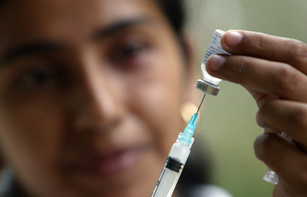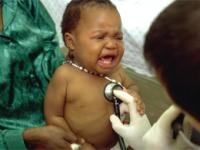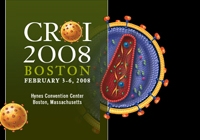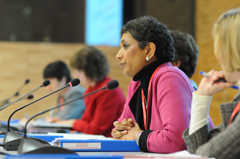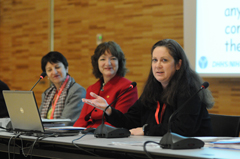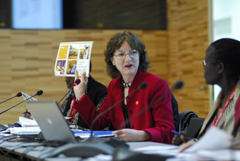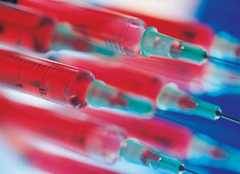In the first of a special three-part web series, www.unaids.org looks at the state of research into new HIV prevention technologies, the ethical debates around the issue, and the steps that have been taken to answer the concerns. The question of HIV trials, and in particular the involvement of women and adolescent girls in them, will be the subject of a two-day conference being hosted by UNAIDS in Geneva December 10-11.
Nearly three decades after AIDS began ringing global alarm bells, no vaccine is in sight and medical advances are still urgently needed. Some significant progress has been seen – biomedical prevention modalities which have been proven highly effective in randomised controlled trials, such as prevention of mother-to-child transmission and male circumcision for HIV risk reduction— still have suboptimal coverage in the most affected countries. Concerted efforts are underway to expand access to these two HIV prevention tools, however nevertheless, the prevention ‘tool box’ needs to be expanded to provide people with additional choices, particularly for prevention of sexual transmission of HIV.
But medical breakthroughs in such a complex disease not only take time—seeking them also poses special practical and, perhaps more critically, ethical problems because of the inevitable need for testing eventually to be done on humans. In recent years, there has been criticism from activist and human rights campaigners about perceived failings in the organisation of human trials. Argument has focused on suggestions of insufficient involvement of local communities in the low- and middle-income countries chosen as sites for testing in the decisions that surround trials, or on the alleged inadequacy of information or guarantees for volunteers taking part in them.
The often very public disputes that ensue have led UNAIDS and other international organisations involved in the AIDS response to refine guidelines for the ethical conduct of human trials.
Need as great as ever
According to the latest data released by UNAIDS and WHO, nearly 7,000 people are newly infected with HIV every day, while the daily death toll from AIDS stands at nearly 6,000 per day, putting it in the top rank of global killers. In sub-Saharan Africa, home to 22.5 million people living with HIV (68% of the global total), AIDS is the primary cause of premature death. Although scientists have succeeded in developing drugs that can prolong the lives of those living with HIV, only a minority of people in need of treatment in developing and middle-income countries has access to it.
Since their launch in 1996, antiretroviral drugs (ARVs) have revolutionised the treatment of HIV-related illness and prolonged and improved the quality of life for people living with HIV in countries where they are available and affordable. But in poorer countries, and particularly in sub-Saharan Africa, where women and adolescent girls make up 61% of the population living with HIV, the cost of drugs remains a huge deterrent to their use, and this is particularly so of second line drugs which people need once first line regimens are no longer as effective for them. “Halting the spread of HIV remains an imperative as each new infection translates into eventual treatment demand. Finding ways to slow HIV transmission is a top research priority,” said UNAIDS Chief Scientific Adviser, Catherine Hankins. “Speeding the search for a biomedical breakthrough to complement changes in social norms and behaviours remains urgent.”
The International Aids Vaccine Initiative (IAVI) estimates that— conservatively—an effective HIV preventive vaccine could avoid almost 1-in-5 of a projected 150 million new infections – that is 30 million – in coming decades. A highly effective vaccine could prevent 70 million infections in 15 years, it says. Modelling of the potential impact of male circumcision in sub-Saharan Africa suggests that male circumcision could avert 2 million new HIV infections and 300,000 deaths over the next ten years and avert a further 3.7 million new HIV infections and 2.7 million deaths in the decade thereafter.
Trials underway
There are currently some 50 vaccine trials underway, or scheduled, in a record number of over 30 countries, ranging from the United States to Uganda. Much of the cutting-edge research is being carried out in Asia and Africa, where most of the new HIV infections are occurring. But the announcement in September 2007 of the discontinuation of a leading HIV Merck vaccine candidate being tested in trials underlines how difficult this type of research and development is and shows just how far there is still to go before a vaccine becomes available.
There are many other prevention strategies undergoing human testing. These include vaginal microbicides, pre-exposure prophylaxis (PrEP), suppression of herpes simplex 2 infection and treating the infected partner in serodiscordant couples to see if it reduces HIV transmission.
Vaginal microbicides come in the form of creams, gels, suppositories, films, sponges or rings that release anti-HIV microbicide over time and could afford protection against other sexually transmitted diseases. If spermicidal, they might also be used for preventing unintended pregnancy. The ideal product would be odourless and colourless. As such, microbicides could increase the options for women who find it difficult or impossible to persuade their partners to use a condom. PrEP is another experimental prevention strategy which is being tried out in many parts of the world. It consists of anti-retroviral medications, taken as a single drug or as a combination, on a daily basis, with the intention of protecting people from acquiring HIV.
The successes achieved so far in the response to AIDS, and future hopes for further advances, have and will depend on such human trials.
Scientists may get promising results in laboratory experiments and from studying animals, but at the end of the day, the only way to find out whether a biomedical HIV prevention strategy is effective, whether a vaccine triggers an immune response to impede or delay the development of disease, whether an intervention has side effects, and the frequency and severity of them, the implications for drug resistance, is to try the strategy out on people.
Protecting rights
Getting scientifically valid research requires that trials be carried out where there are sufficiently high numbers of infected people, and people at high risk of HIV exposure, and where effective interventions will have the greatest effect. This often means dealing with some of the most socially vulnerable sectors of society, whether they are women and girls in sub-Saharan Africa, sex workers, men who have sex with men or injecting drug users. And often, people most at risk may not be well placed to protect their rights in the run-up to and the preparation of testing, during the trial programme itself or in its aftermath.
A lack of information and the relative powerlessness of some communities could produce situations in which there is an unequal power relationship between research sponsors and trial investigators, on the one hand, and communities and trial participants on the other. People could, for example, opt to take part out of the false belief that there will be some immediate therapeutic benefit to them, which could even lead them to behave in a more risky fashion because they feel protected. Building research literacy and community capacity to engage meaningfully in trial design, conduct, monitoring and results dissemination is essential to minimising harms and maximising the benefits for communities of participation in research.
Ethical questions
One of the most controversial incidents in the history of AIDS research occurred in the early 1990s during testing of a shorter, simpler, and presumably cheaper version of perinatal zidovudine prophylaxis. Zidovudine was already known to be an effective barrier to the transmission of HIV from a mother to her unborn or newly born infant. The trials involved randomised placebo-controlled tests and were carried out in a number of developing countries. Activists argued that a placebo controlled trial amounted to a violation of fundamental ethical principles because those being given the placebo were being denied a treatment that had already proved its worth elsewhere. Zidovudine was one of the milestones in HIV research and had been shown to cut mother-to-child transmission by over 60%, offering tremendous hope to pregnant women. Subsequent improvements have reduced such transmissions in high-income countries to just 1-2 percent.
Another well-known incident surrounded randomised placebo-controlled trials for tenofovir disoproxil fumarate used as PrEP, in Cambodia and Cameroon in 2004-5. The Cambodian trial involving sex workers was halted by the government when no agreement was reached on future access to treatment for those who became infected during the trial. The affair generated much adverse news coverage and the Cameroon government followed suit in suspending the trial underway there.
In Thailand, a trial in which the participants were injecting drug users was criticised by activists for not providing clean needles. In one protest that gained much publicity, the activist group Act-Up Paris stormed the display stand of tenofovir’s manufacturer, Gilead, during the 2004 International AIDS Society Conference.
Health community responds
Much has been learned and acted upon from these experiences. For example, in 1993 the Council for International Organisations of Medical Sciences (CIOMS) issued international ethical guidelines for biomedical research involving human subjects that stated that there was an ethical responsibility to provide treatment that conforms to the standard of care in the sponsoring country when possible.
In 2000 came the fifth revision of the Declaration of Helsinki with its stipulation that all those involved in studies be assured of the best “proven diagnostic and therapeutic method”. The same year saw publication of the UNAIDS guidance document “Ethical considerations in HIV preventive vaccine research” which has now been substantially revised in 2007 in collaboration with WHO and an expert panel to reflect changes, particularly changes in standard of prevention and access to care. “Ethical considerations in biomedical HIV prevention trials” contains 19 guidance points for ensuring that scientifically rigorous biomedical HIV prevention trials meet ethical standards.
In 2005, following the tenofovir case, UNAIDS and others organised consultations focusing on ‘partnerships’ with communities, their involvement, standards of prevention and access to care. This led to UNAIDS producing in collaboration with AVAC “Good Participatory Practice Guidelines for Biomedical HIV Prevention Trials,” It covers core principles and essential activities throughout the research life-cycle, providing a foundation for community engagement in research.
“With solid international guidance in place for community engagement and the ethical conduct of trials, there is anticipation that research, both underway in the field and planned, can offer a number of promising new avenues to prevent HIV transmission, improve treatment and mitigate against the epidemic’s impact,” said Dr Hankins.
The question of HIV trials, and in particular the involvement of women and adolescent girls in them, will be the subject of a two-day conference being hosted by UNAIDS in Geneva December 10-11. On Wednesday 5 December, part two of this special web series will take a closer look at the history and debates around the involvement of women and girls in trials. Part three, to be published on Friday 7 December will preview the Geneva meeting, featuring interviews with the four organizing partners UNAIDS, The Global Coalition on Women and Girls, Tibotec and the International Center for Research on Women (ICRW).
Links:
Three-part web series
Part 1: Meeting ethical concerns over HIV trials
Part 2: The role of women in HIV trials
Part 3: Experts meet on women and HIV clinic trials
More on biomedical research
HIV Prevention Research: A Comprehensive Timeline
Global Coalition on Women and AIDS
Tibotec
International Center for Research on Women (ICRW)
Publications:
Ethical considerations in biomedical HIV prevention trials (pdf, 750kb)
Good participatory practice guidelines for biomedical HIV prevention trials (pdf, 3.04Mb)




